
Importance
AOT’s operations—ranging from construction projects to airport service activities—depend significantly on employees and business partners, including contractors and external service providers. Therefore, robust occupational health and safety (OHS) management is essential, as it directly impacts the organization’s most valuable assets: its people. Inadequate OHS practices may result in occupational accidents, injuries, or fatalities involving employees or contractors. Such incidents not only compromise workforce safety but also indirectly affect service delivery, community relations, and regulatory compliance, potentially constituting violations of fundamental human rights, particularly the right to life and safety.
For AOT, the absence or insufficiency of OHS management may have a direct impact on operational continuity, such as disruptions to construction activities or airport services due to the unavailability of critical personnel. Moreover, it may undermine stakeholder confidence—especially among passengers, customers, and neighboring communities. Non-compliance with regulatory requirements may also damage the organization’s reputation and expose it to legal liabilities. As such, the management of occupational health and safety must be undertaken systematically and in accordance with relevant standards to ensure organizational sustainability and build stakeholder trust.
Policy
AOT Occupational Health, Safety, and Workplace Environment Policy
Airports of Thailand Public Company Limited (AOT) is committed to operating and managing airports of international standards, with exceptional service quality and a strong sense of responsibility toward society, the environment, and local communities. AOT places high importance on safeguarding the health, safety, and working environment of all employees and personnel.
The Company emphasizes proactive accident prevention and risk mitigation measures for employees and stakeholders at all levels, reflecting its responsibility to ensure occupational health and safety for all relevant parties—including AOT employees, contracted workers, service providers, general public, and individuals performing duties within AOT premises. These efforts aim to establish a reliable and sustainable working standard.
AOT is committed to continuously implementing this policy to foster confidence in workplace safety and well-being for all personnel and the organization as a whole. This policy encompasses the following key principles and practices:
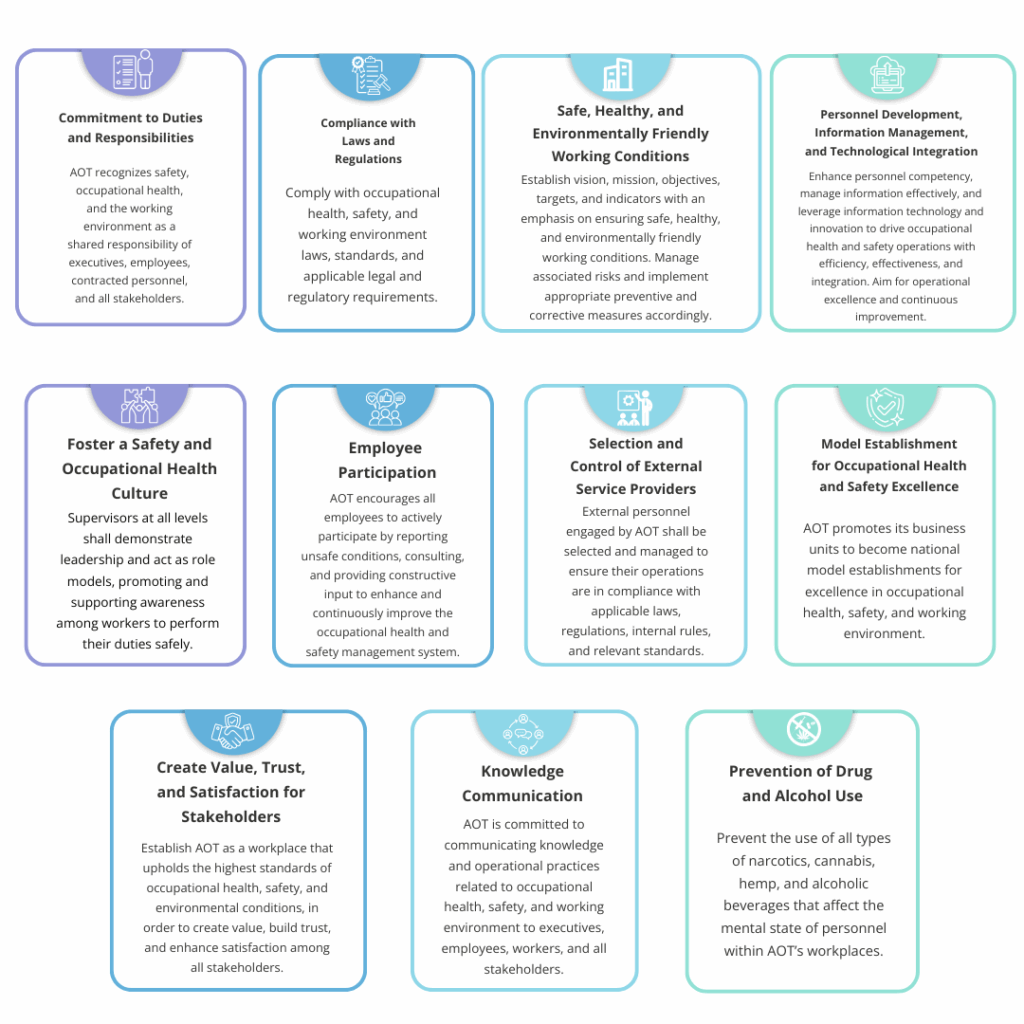
Airports of Thailand Public Company Limited (AOT) is committed to the continuous development and enhancement of safety standards to ensure the confidence of passengers, employees, and stakeholders in AOT’s aviation operations. These operations are conducted with a strong emphasis on safety, aligned with AOT’s corporate strategies and core values under the framework of sustainable development. AOT adheres to relevant international occupational health and safety (OHS) standards and adopts industry best practices to foster a secure and reliable environment. In addition, AOT is committed to setting up prioritization and action plans together with an establishment of quantitative targets for improving OHS performance metrics.
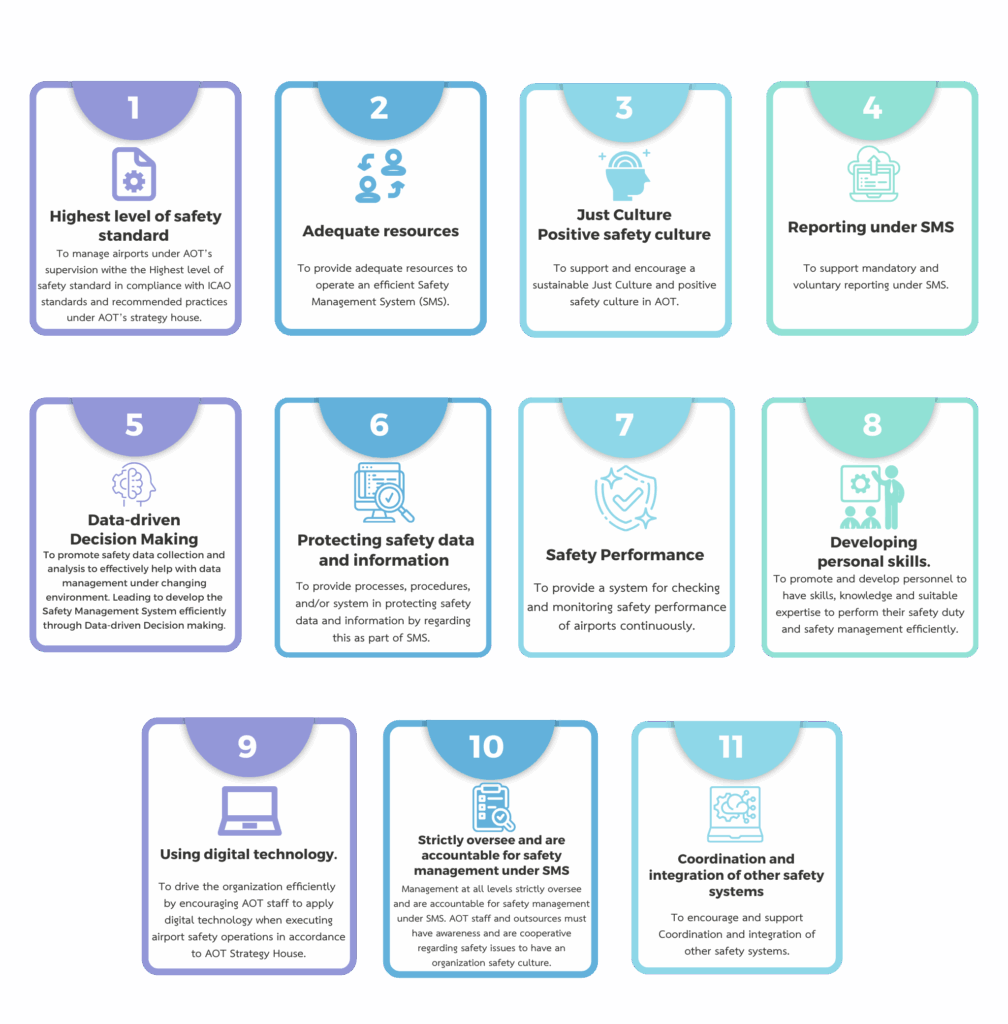
In addition, AOT has established the Occupational Health and Safety Management System Manual, along with official regulations and safety handbooks for contractors, to serve as practical guidelines for all employees, staff, and contractors of AOT. These documents apply to operations at all AOT-managed airports and the Head Office.

Management Approaches
Roles and Responsibilities
AOT has designated responsible personnel for occupational health and safety at its six airports and Head Office, as follows:

AOT’s Safety, Occupational Health, and Work Environment Committee (SHE Committee) performs 11 duties and responsibilities in accordance with the Ministerial Regulation on the Standard for Administration and Management of Occupational Safety, Health, and Environment B.E. 2549 (2006).
The committee is composed of a Chairperson (appointed by the employer), a Professional Safety Officer (serving as both committee member and secretary), employer representatives at the supervisory level (appointed by the employer), and employee representatives from all levels (elected). The number of employer and employee representatives must be equal.
The Committee convenes at least once a month to review performance outcomes and provide recommendations on occupational health and safety measures to support continuous improvement in management efficiency.
In addition, AOT has established the Board Oversight of Health and Safety responsible for setting and reviewing the strategic direction and action plans related to occupational health and safety. This board also oversees and monitors the implementation to ensure alignment with AOT’s strategic objectives.
Strategic Action Plan for Occupational Health and Safety Management System
Airports of Thailand Public Company Limited (AOT) reaffirms its commitment to continuous improvement in occupational health and safety by formulating a new strategic plan entitled “Organizational Context and Strategic Action Plan for Occupational Health and Safety Management System for Fiscal Years 2024–2027.” This plan aims to enhance the standards of occupational health and safety across the organization and reduce accident rates by the year 2027.
The plan is aligned with the AOT Corporate Plan for Fiscal Years 2023–2027 (Revised Edition for Fiscal Year 2024) and reflects the current organizational context and future trends in the airport management industry.
AOT envisions the development of an exemplary Occupational Health and Safety Management System (OHSMS) that effectively supports its mission as a world-class airport operator. This strategic direction emphasizes service excellence, operational safety, and sustainable revenue generation. The implementation is guided by five key strategies and core initiatives, as outlined below:
| Strategy | Projects |
|---|---|
| Strategy 1: Leadership & Culture Development |
|
| Strategy 2: Competency & Knowledge Management |
|
| Strategy 3: Operational Efficiency |
|
| Strategy 4: Outsource & Contractor Control |
|
| Strategy 5: Risk Monitoring Data |
|
Goals and Key Performance Indicators (KPIs) for Occupational Health, Safety, and Workplace Environment
AOT has established key performance indicators (KPIs) on occupational health, safety, and working environment for relevant departments, with annual reviews. These indicators serve as a framework to guide operations in compliance with legal requirements and the ISO 45001:2018 standard, and to support the achievement of a “Zero Accident” target in the workplace.
| Indicators | Annual Goals |
|---|---|
| Number of fatalities | 0 |
| Lost Time Injury Frequency Rate (LTIFR) | 0 |
| Lost Time Injury Severity Rate (LTISR) | 0 |
| Number of Occupational Illness Cases | 0 |
Operations according to standards
|
100% According to standards and plans |
| Recognized with the National Award for Excellence in Occupational Safety, Health, and Workplace Environment. | Be awarded |
| Maintain ISO 45001:2018 Certification Status | 100% |
| Zero Accident on Runways | 0 |
Guidelines for Occupational Health and Safety Procedures (OHS Procedures)
Airports of Thailand Public Company Limited (AOT) has established a Standard Operating Procedure (SOP) as a systematic guideline for the implementation of occupational health and safety for personnel, including employees and business partners. The procedure requires relevant personnel to regularly convene meetings with the Human Resources Department and the designated committees to report on operational performance and updates concerning occupational health and safety.

AOT’s Standard Operating Procedure (SOP) for Occupational Health and Safety covers the following areas:
- Hazard Identification and Risk Assessment
- Management of Psychosocial Hazards and Work-Related Social Factors
- Compliance Management for Occupational Health and Safety Legal and Other Requirements
- Establishment of Occupational Health and Safety Objectives and Management Plans
- Determination of Competence, Training, and Awareness
- Communication, Participation, and Consultation
- Control of Documents and Records
- Operational Control
- Management of Organizational Changes
- Procurement and Contractor Management
- Emergency Preparedness and Response
- Safety Compliance Inspection
- Monitoring, Measurement, and Performance Evaluation of OHS Implementation
- OHS Management System Auditing
- Management Review of the OHS Management System
- Incident and Accident Investigation, Corrective, and Preventive Actions
Hazard Identification and Occupational Health and Safety Risk Assessment
AOT adopts a systematic approach to identifying hazards and assessing occupational health and safety (OHS) risks. Risks are prioritized based on their severity and likelihood, with targeted corrective action plans established accordingly. These plans include clearly defined, measurable objectives. The process is fully integrated into the organization’s overall safety management system to ensure long-term sustainability and continuous improvement.
OHS Risk & Hazard Assessments
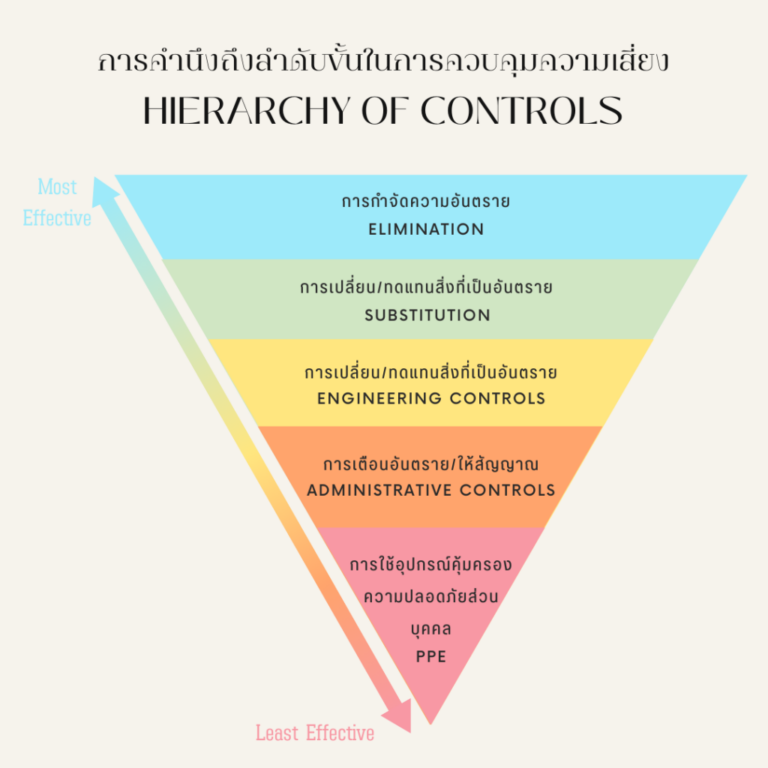
AOT implements its occupational health and safety management in accordance with the Thai Industrial Standard (TIS) 18001:2554. The hazard identification and risk assessment processes cover both AOT employees and suppliers/vendors operating within AOT’s premises. These assessments are reviewed at least once a year by the responsible personnel of each unit in collaboration with professional safety officers and reported to the Occupational Health and Safety Management System Executive Committee (SHE Committee) and senior management to evaluate progress in reducing/preventing health issues/risks against targets.
Findings from the hazard identification and risk assessments are utilized to define appropriate risk control measures in accordance with the hierarchy of controls, aiming to ensure the most effective preventive actions. In cases where workers identify potentially hazardous working conditions, personnel at all levels are encouraged to report risks and concerns to the SHE Committee at any time. Such reports are considered opportunities for system improvement and enhancement of the occupational health and safety management system.
Prioritization and Integration of Quantitative Target-Based Action Plans for Risk Mitigation
In the risk assessment process, AOT establishes a comprehensive risk evaluation matrix by identifying the source of hazard, the nature of the hazard, and its potential impacts. The severity and likelihood of each identified hazard are assessed using a structured scoring system to determine the overall risk level, categorized as L (Low), M (Medium), or H (High).
This risk level is then used to prioritize corrective actions. For risks assessed as medium or high, specific action plans must be developed, with clearly defined quantitative objectives. These may include enhancing preventive measures, employing appropriate protective equipment, or improving the working environment to reduce or eliminate risks.
Investigation of Incidents
In the event of an incident, AOT has established the following incident investigation procedures, which cover work-related injuries, ill health, diseases and incidents:


Workplace Environmental Assessment
AOT conducts regular assessments of the working environment for its employees and workers. Responsible units for occupational health and safety, together with environmental departments at each airport, are tasked with inspecting and monitoring workplace conditions to ensure compliance with relevant occupational health, safety, and environmental laws and standards. The assessment covers various aspects of indoor environmental quality, including temperature, humidity, lighting, noise levels, particulate matter, and airborne bacteria and fungi.
Medical Services
AOT provides medical clinics and first aid rooms at all six airports, as well as at the Head Office, to offer initial medical treatment for employees and personnel working within AOT premises in cases of illness or injury occurring during duty. In addition, AOT arranges annual health check-ups and offers medical benefits to ensure that all employees maintain good health and receive proper care. These measures aim to promote quality of life and ensure consistent readiness for work.

Safety for Contractors and Contractor Selection
AOT has developed and disseminated safety regulations and manuals for contractors to ensure that work is carried out safely and in full compliance with applicable laws and standards. These guidelines help mitigate risks associated with contractor operations within AOT premises, reduce the likelihood of accidents, and prevent potential impacts. They also promote safety performance for all workers, including external contractors.
AOT has established a Standard Operating Procedure (SOP) for procurement and contractor control. This SOP outlines clear criteria and guidance for departments engaging contractors, with specific occupational health and safety requirements that must be followed when contracting services. It ensures compliance with occupational health and safety laws, ISO 45001:2018 standards, and the incorporation of sustainable practices. Such requirements are explicitly stated in the Terms of Reference (TOR), including conditions for safe contractor operations.
Furthermore, AOT ensures that safety requirements are communicated to all contractors before commencing any work. This includes a briefing on safety protocols to guarantee full compliance, minimize risks, and maintain a safe and standardized work environment.
Currently, contractors are required to submit monthly safety performance reports through AOT’s contractor safety information management system. AOT also inspects and verifies contractors’ work permits prior to the start of any operation within its premises.

Employee Health Care
Based on risk assessment results, AOT has implemented various projects and activities to promote employee health and safety, including continuous epidemic prevention. These initiatives include:
- Annual health check-ups
- Internal sports competitions organized by AOT
- Specialized training for high-risk workers
- Emergency preparedness programs
- Safety talk sessions within departments
- Ergonomics programs to improve workplace posture and reduce strain
Occupational Health, Safety, and Workplace Environment Inspections (Independent External Verification & Internal Inspections)
AOT places great importance on maintaining a safe and occupationally sound working environment, free from hazards and accidents, across all six airports and the Head Office. This principle is considered fundamental to airport operations, and all personnel working within AOT’s premises are required to comply accordingly.
Currently, AOT’s Occupational Health and Safety Management System has been fully certified under ISO 45001:2018 for both the Head Office and all six airports. This management system enhances the effectiveness of occupational health and safety operations in line with internationally recognized standards.
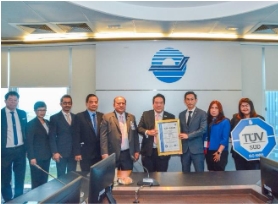
In addition, AOT conducts regular internal audits on occupational health, safety, and environmental practices to identify any non–conformities with ISO 45001:2018. Corrective action plans are developed accordingly, and progress is closely monitored through ongoing evaluations and meetings throughout the fiscal year to ensure continuous improvement and alignment with strategic targets.
Performance
Training program for the course “Enhancing Front Line Potential in Basic Life Support Medical Assistance” for the year 2024
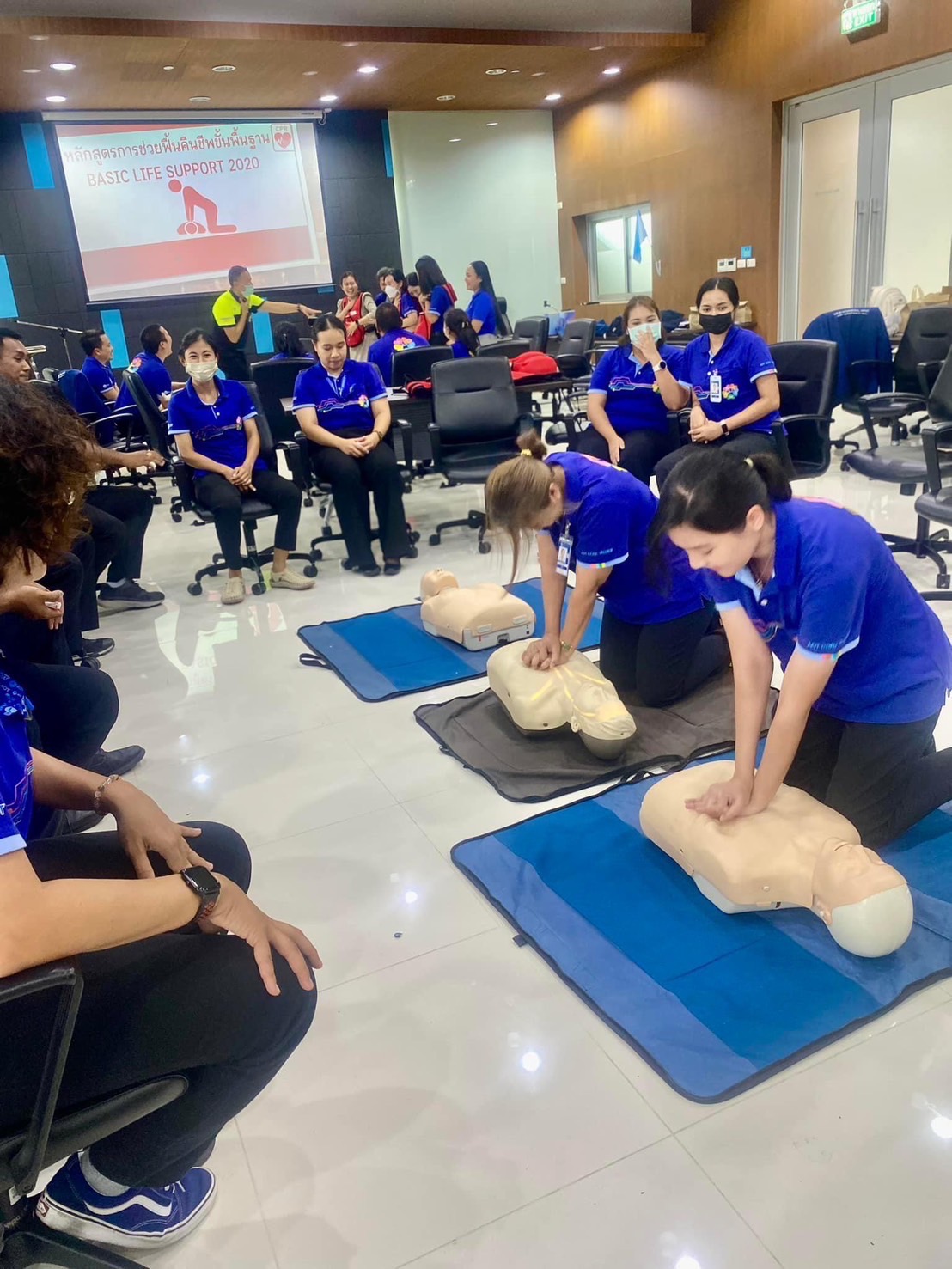
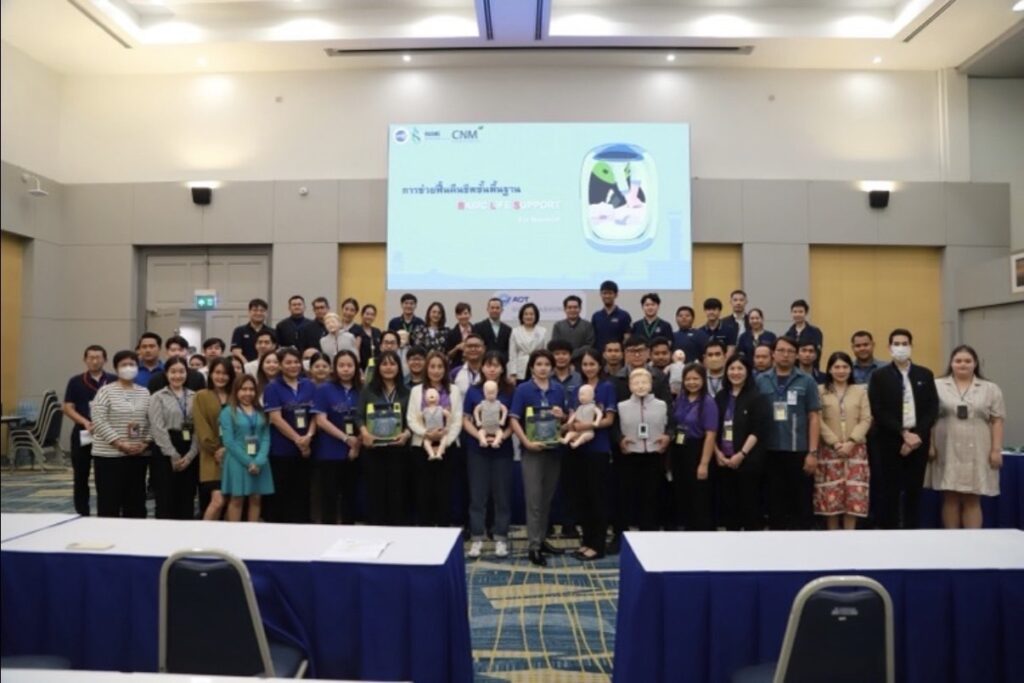
The objective is to provide training to 560 participants from the Head Office, six airports, and airlines to equip them with the skills, knowledge, and understanding necessary to perform Basic Life Support (BLS) and properly use an Automated External Defibrillator (AED) effectively and safely. This training aims to increase the chances of survival for individuals experiencing sudden cardiac arrest, while ensuring safety for passengers, airport users, and AOT personnel. It also contributes to enhancing the organization’s public image. In addition, the Human Resources Development Department and the Medical Department have conducted training sessions for AOT staff who directly interact with service users at the Head Office and all AOT-operated airports.
Employee Health and Safety Promotion Project
AOT produced a series of four health promotion video clips for all employees and workers, focusing on office syndrome. The objective is to raise awareness, promote health knowledge, and provide practical guidelines for personnel at the Head Office and all six AOT-operated airports. In 2024, AOT expanded communication channels to ensure broader coverage by broadcasting the videos through desktop screens as part of the organization’s internal communication strategy.
Episode 1: Physical exercises for the prevention and relief of office syndrome symptoms.
Episode 2: Raising awareness and educating personnel to stop or avoid risky behaviors that may lead to office syndrome.
Episode 3: Strengthening muscles and body parts that are prone to office syndrome.
Episode 4: Introducing proper workplace arrangement methods based on ergonomic principles.
Measures to Safeguard Employee Health and Safety During Epidemic Situations
In response to the widespread outbreak of COVID-19 across many countries, AOT—being a national infrastructure operator serving domestic and international passengers—was directly affected by the pandemic. To address this, AOT developed a dedicated Incident Management Plan for emerging diseases or serious epidemics. This plan serves as a framework and operational procedure to ensure continued airport operations while protecting all AOT employees and stakeholders.
Promotion of Occupational Health and Safety Culture
AOT promotes safety awareness and supports a strong safety culture within the organization by organizing training sessions and awareness campaigns. These include regular monthly workplace safety inspections by each department, and Safety Talks that encourage employees to engage in discussions on safety-related topics to foster knowledge-sharing. In addition, the Safety Day program raises awareness and encourages employee participation through interactive safety education booths, supported by safety communication materials and incentive giveaways for participants. To strengthen internal knowledge, AOT provides both new and current employees with fundamental safety training in accordance with legal requirements and International Civil Aviation Organization (ICAO) standards. This includes basic airport safety protocols, emergency response planning, fire drills, and supervision training for employees responsible for overseeing contractors.
Furthermore, in promoting a safety-first culture within airport operations, AOT requires all relevant contractors and business partners involved in safety and security operations to complete AOT-led safety training courses prior to beginning work.
Fire Drill and Evacuation Training Program
AOT has implemented fire drill and evacuation training in accordance with its Fire Prevention and Suppression Plan, led by the Occupational Health and Safety Department. The objective is to prevent loss of life and property from fire incidents and to ensure that employees feel confident and safe in the event of a fire. These drills aim to minimize risks and losses, comply with legal requirements, and strengthen emergency preparedness. In addition, AOT regularly provides basic fire safety training for employees and conducts annual fire evacuation drills as mandated by law.
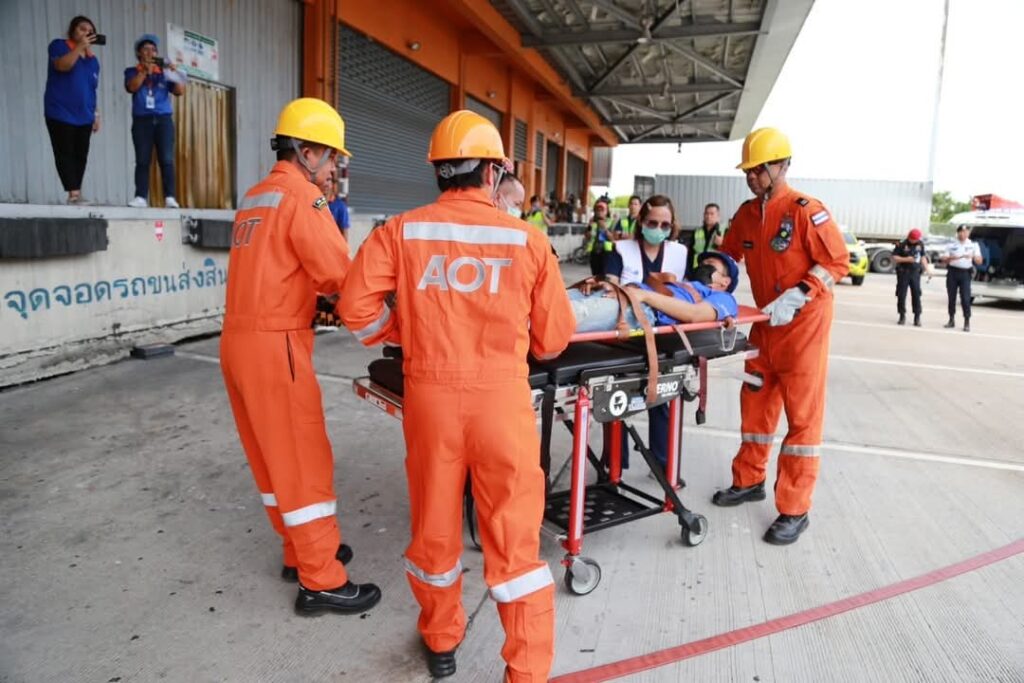
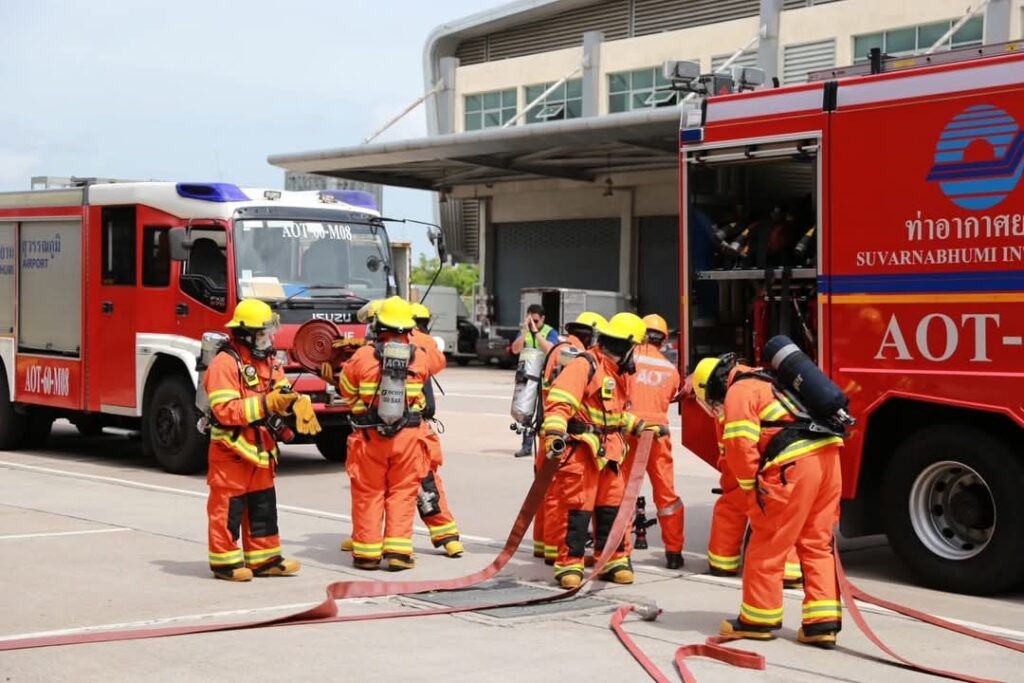
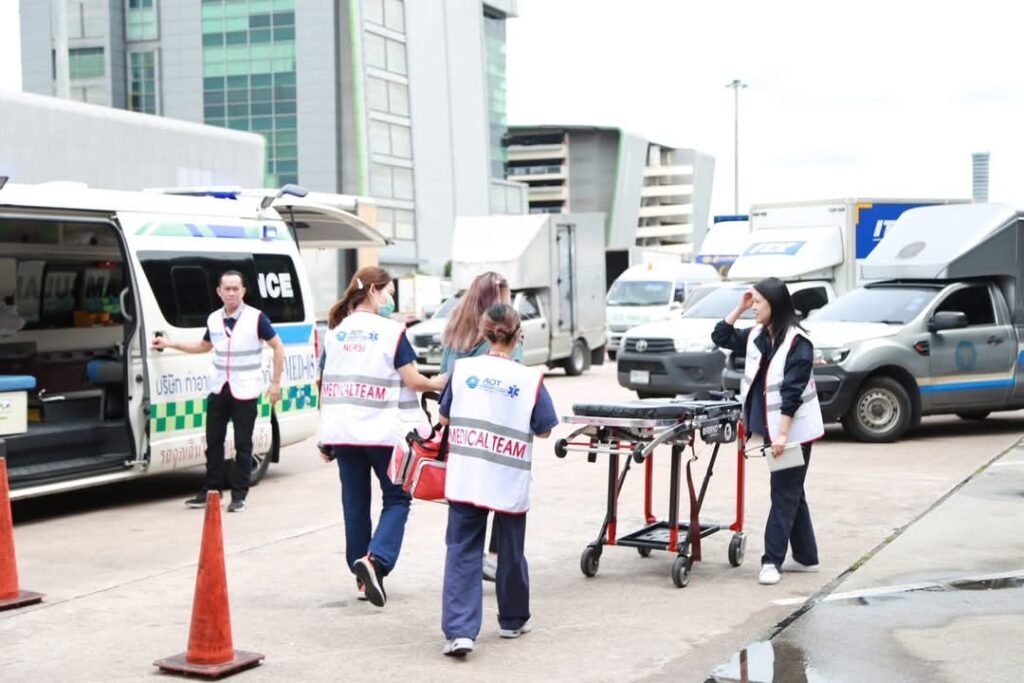
Work-Related Injury Statistics for Employees and Workers
AOT compiles and maintains statistics on occupational safety using two key metrics: the Lost Time Injury Frequency Rate (LTIFR) and the Lost Time Injury Severity Rate (LTISR). These indicators follow the methodology established by the American National Standards Institute (ANSI), covering both AOT employees and related contractors. The data is analyzed to identify root causes of incidents and used to develop risk mitigation plans and preventive measures. All reported statistics are subject to verification by a certification body in accordance with the ISO 45001:2018 standard prior to certification approval.
- LTIFR (Lost Time Injury Frequency Rate) = (Number of lost-time injury cases × 1,000,000) / Total working hours
- LTISR (Lost Time Injury Severity Rate) = (Number of lost workdays × 1,000,000) / Total working hours
Evaluation of Occupational Health and Safety (OHS) Management
AOT conducts regular assessments of its occupational health, safety, and working environment management through internal audits, carried out by the Occupational Safety and Health Division, Aerodrome and Aviation Standards Department, and the Occupational Health and Safety Committee. External audits are also conducted by independent organizations to assess compliance with the ISO 45001:2018 standard. Safety statistics and audit outcomes are regularly reported to AOT’s senior management for review and for determining further improvement measures. In addition, AOT discloses its OHS performance publicly through its annual sustainability report.
